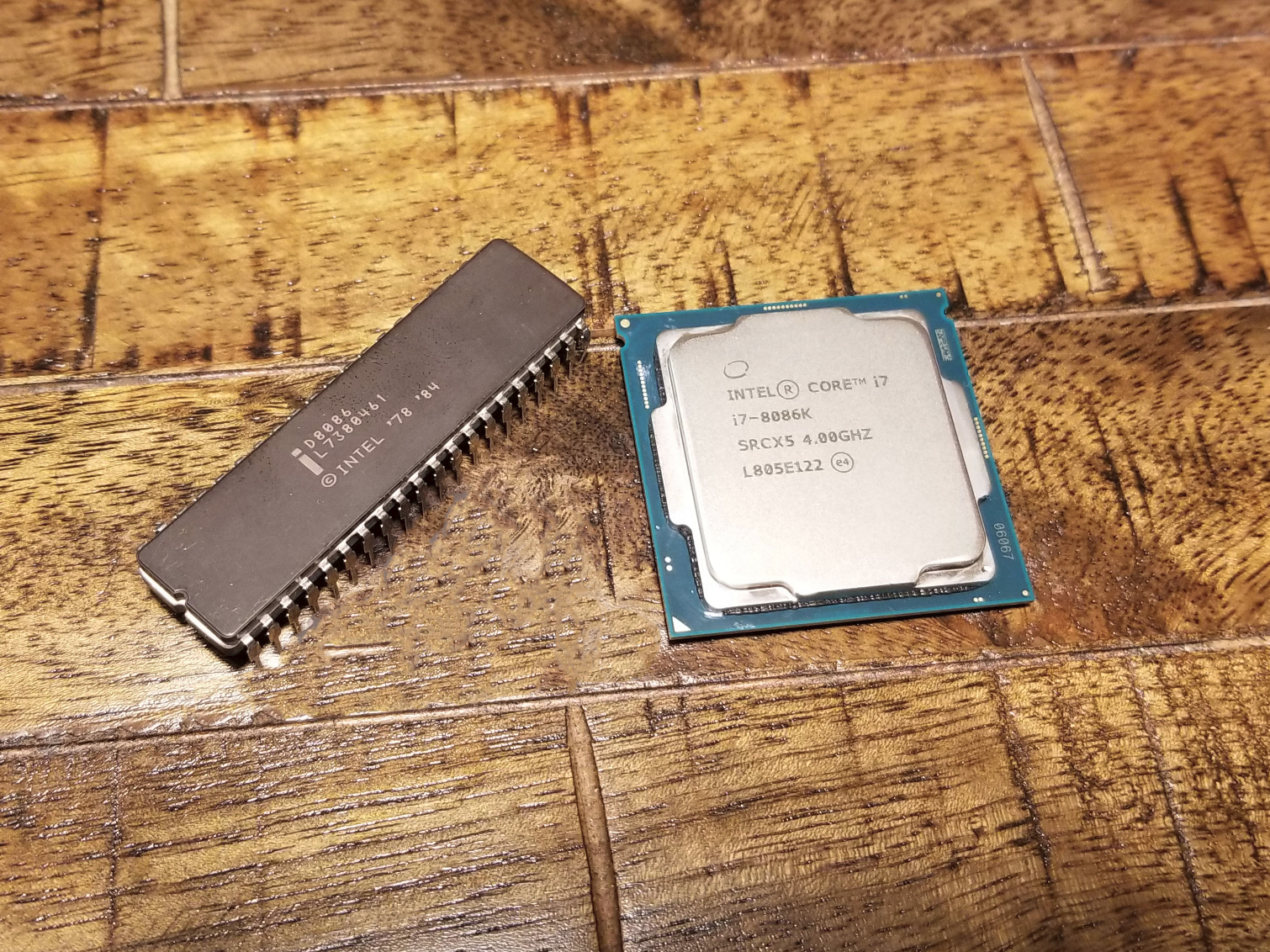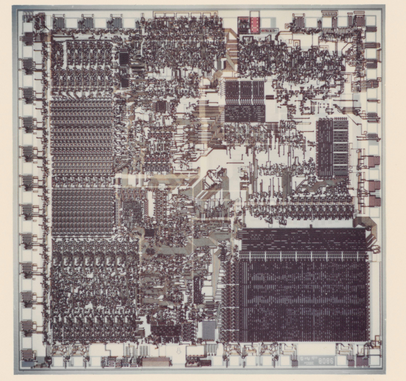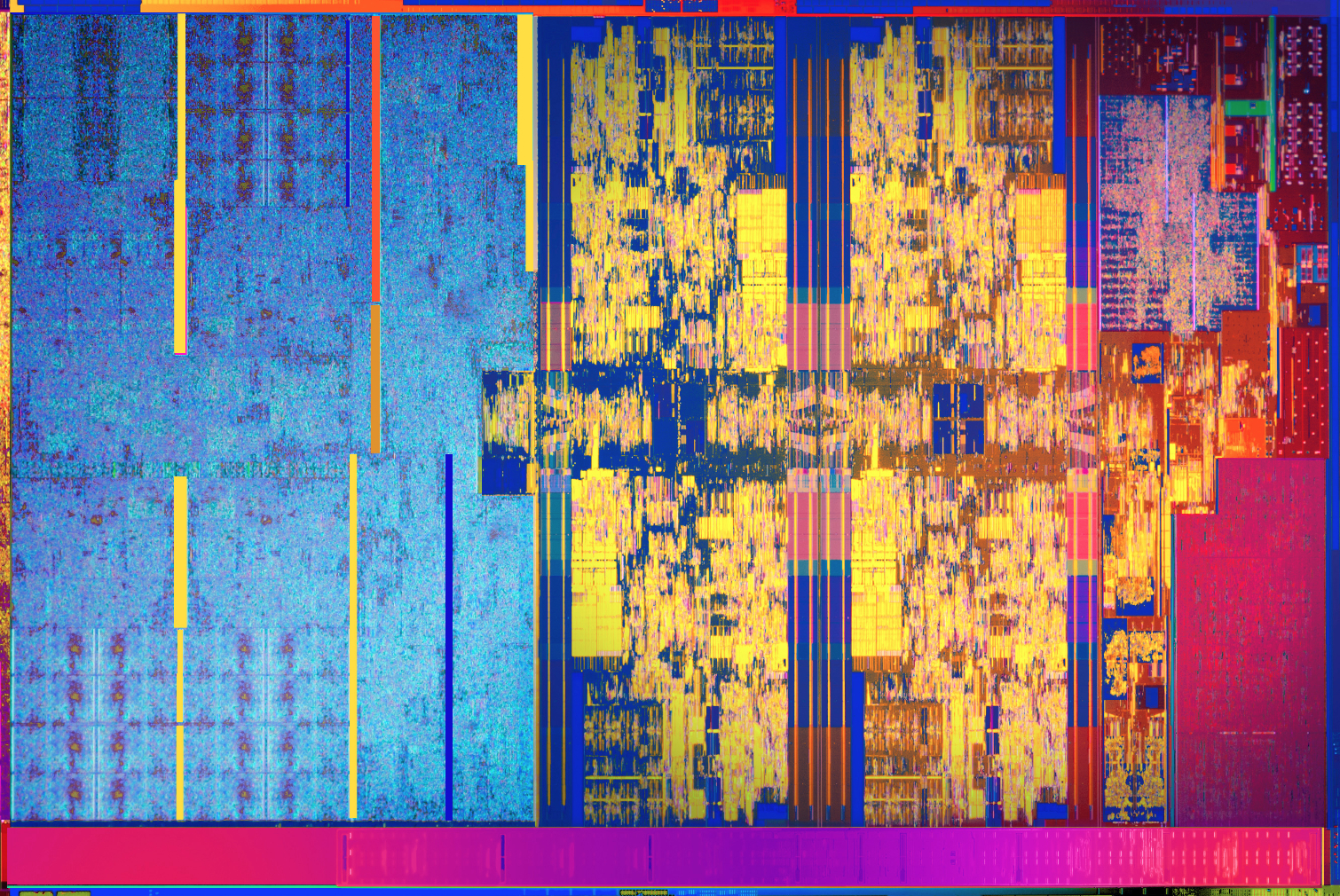The Core i7-8086K Review: 40 Years Of x86
Why you can trust Tom's Hardware
Forty Years Of x86
Compared to the 16-bit 8086, Intel's Core i7-8086K represents a quantum leap in technology. Whereas a modern CPU can spend four years in the design process, Intel brought its 8086 to market in just 18 months. Stephen Morse, then 36 years old, was the lead architect. The 8086 was originally designed to be a filler product before Intel released the 8800, but Morse designed it to be the first in a line of chips that shared a common architecture to ensure forward compatibility.
| Product | Intel 8086 | Core i7-8086K | Core i7-8700K |
| Release Date | June 8, 1978 | June 8, 2018 | October 5, 2017 |
| TDP | 1W (power draw) | 95W | 95W |
| Cores / Threads | 1 / 1 | 6 / 12 | 6 / 12 |
| Frequency Base / Boost | 5 - 10 MHz (0.005 GHz) | 4.0 / 5.0 GHz | 3.7 / 4.7 GHz |
| Transistors | 29,000 | ~3 billion | ~3 billion |
| Manufacturing Process | nMOS/HMOS 3 micron (3000nm) | CMOS 14nm++ | CMOS 14nm++ |
| Word Size | 16-bit | 64-bit | 64-bit |
| Lithography | G-Line (Mercury Arc Lamps) 436nm Wavelength | Argon Fluoride Excismer Laser, 193nm Wavelength | Argon Fluoride Excismer Laser, 193nm Wavelength |
| Die Size | 33mm2 | 149mm2 | 149mm2 |
| Minimum Feature Size | 3.2 Microns (3200nm) | 8nm | 8nm |
| Wafer Diameter | 4 inches | 12 inches | 12 inches |
| Memory Support | 1MB | 64GB | 64GB |
| Memory Bus Speed | 4.77 MHz | 2966 MHz | 2966 MHz |
| Integrated Graphics | None | UHD Graphics 630 | UHD Graphics 630 |
| Socket | 40-pin | LGA 1151v2 | LGA 1151v2 |
| Price | $86.65 (1978) $330 adjusted for inflation | $425 | $359 |
And thus, the x86 instruction set architecture was born. Over the course of 40 years, Intel continually enhanced the x86 ISA, adding more than 3500 new instructions like MMX, SSE, TSX, and three flavors of AVX, among many others. Amazingly, the 64-bit Core i7-8086K is capable of running original 16-bit 8086 code. That's a testament to the x86 instruction set's longevity.
The original 8086 was fabbed on a 3200nm nMOS process using mercury arc lamps. Meanwhile, 40 years later, Intel is on its third-gen 14nm CMOS process that's manufactured with argon fluoride exerciser lasers.
Transistor measurements are no longer based strictly on feature sizes, but we can derive some basic comparative metrics. Die sizes have increased from the 8086's 33mm2 to the -8086K's 149mm2, and transistor counts are up from 29,000 to ~3,000,000,000 per processor, respectively. That means the original 8086 featured 879 transistors per square millimeter, while Core i7-8086K comes with 20,134,228 transistors per square millimeter for an astounding 22,905x density increase.
Interfaces have also changed as Intel added more cores, cache, new buses, expanded memory support, and on-die graphics. The original 8086 dropped into a 40-pin quasi-PGA interface, whereas the eighth-generation Core processors employ an LGA 1151v2 socket that boasts 1151 pins. If we widen the scope to Intel's 28-core enterprise behemoths, some interfaces pack a whopping 4637 pins.
MORE: Best CPUs
MORE: Intel & AMD Processor Hierarchy
Get Tom's Hardware's best news and in-depth reviews, straight to your inbox.
MORE: All CPUs Content
Current page: Forty Years Of x86
Prev Page Intel Core i7-8086K 40th Anniversary Model Next Page Silicon Lottery, Overclocking & Test Setup
Paul Alcorn is the Editor-in-Chief for Tom's Hardware US. He also writes news and reviews on CPUs, storage, and enterprise hardware.
-
AgentLozen Cons:Reply
-No bundled cooler
You're saying that if Intel paired their little aluminum heatsink with this CPU you would have been more satisfied with this product?
I've never heard of this silicon lottery place before. That's neat stuff. -
-Fran- I'm going to be unfair, but not too much:Reply
- We doing something for the 40th anniversary? -> Yes.
- What do we sell for the 40th anniversary? -> A re-branded 8700K.
- What do we include to make it more expensive? -> A letter from the CEO we most definitely won't be firing in the upcoming weeks! And a weird bottle with coffee beans in it (it seems?).
- Do we bother in making it special (metal solder, bundled CLC, etc...) or just pick a couple golden sample 8700Ks? -> Don't bother, shrinks our profit; we don't care about the anniversary or making this special, really.
Too much cynical thought process there?
Cheers! :P -
Paul Alcorn Reply21093123 said:Cons:
-No bundled cooler
You're saying that if Intel paired their little aluminum heatsink with this CPU you would have been more satisfied with this product?
I've never heard of this silicon lottery place before. That's neat stuff.
Touché
;)
-
ingtar33 so Intel releases 8000 binned cpus for a $100 markup over their basic cpu, plus some crap, however, this release is by lottery only (as in only the lotto winners have permission to buy this chip), and THG does a review?Reply
seriously? -
mister g " But if you go the Silicon Lottery route, expect to pay even more than a brand new Core i7-8086K costs and lose two years of warranty coverage."Reply
I thought Intel CPUs usually come with a 3 year warranty? -
Math Geek Reply21093328 said:this release is by lottery only (as in only the lotto winners have permission to buy this chip), and THG does a review?
seriously?
think you missed how it went. they did a drawing to give away a bunch of these chips but they also made the rest available for purchase through the normal routs. no lottery there, just have to be quick on the draw and buy one before they sell out. Tom's bought thier's the same way any of us could have since intel did not send out press samples of it. it's a valid product for sale like any other they review. -
g-unit1111 Reply21093123 said:Cons:
-No bundled cooler
You're saying that if Intel paired their little aluminum heatsink with this CPU you would have been more satisfied with this product?
I've never heard of this silicon lottery place before. That's neat stuff.
Yeah I noticed that too. Intel hasn't been bundling coolers with its' high end CPUs since the X79 days. I honestly wouldn't count this as a hit against it. -
Krazie_Ivan and lets check in with Paul on those 8086k temps...Reply
https://i.pinimg.com/originals/54/23/5a/54235a5fac7cee9c208e0838115f1752.jpg


